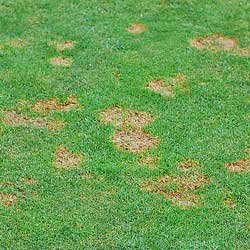Bare Patchy Lawns
If you’re looking out at your lawn and thinking, “the only solution is to rip it up and start again”, it’s time to think again. If your lawn is looking old, brown, worn and severely weedy and moss-ridden you may well suspect that the only solution is to start all over again. But that’s normally not required and could end up costing you a fortune that you don’t need to spend. f you have a no-hope lawn, why not organise a no-obligation Greenfeet assessment which will establish very quickly if your lawn (and your budget) can be saved or not. If there’s any life left in your lawn, we’ll give you a fixed price for a programme of treatments that’ll have your lawn looking beautiful and healthy again without breaking the bank.
The main causes of patchy lawns we encounter are:
- Diseases - wet and dry diseases.
- Pests - Grubs and Insects.
- Physical - Mower scalping.
-Chemical - Dog urine and fertilizer burn.
- Soil related - Fairy rings and thatch.
- Aspect - Light and shade patterns.
With any problem with your lawn, getting the correct diagnosis is all important. At Greenfeet we come and analyze your lawn to establish exactly what problem is causing the bare patches. We then provide a tailored solution to suit your needs.
Aspect
The aspect of a garden relates to how the sun moves the shade around your garden The overall amount of light your lawn receives depends on its aspect, the direction your garden faces.
- North-facing gardens get the least light and can be damp.
- South-facing gardens get the most light.
- East-facing gardens get morning light.
- West-facing gardens get afternoon and evening light.
A lack of light in all cases will impede the growth of grass. The grass leaves become thinner as they grow upwards in search of light causing the sward to thin out leaving bare patches. One of the biggest causes of patchy lawns is improper mower set up. If the mowing height is set too low or if there is a variation in the height from one side of the mower to the other you will get scalping. Scalping grass too low will remove the crown of the grass. This means the grass cannot re-grow new leaves and will die causing a bare patch.
Chemical Damage
Fairy Rings
Thatch
The most common types of chemical damage we see on lawns is where a fertilizer has been applied incorrectly or where a lawn has been burnt by animal urine. Where a dog is urinating on a lawn it can cause brown patches on the grass. This is caused by an overload of nitrates. Dogs do produce nitrates as a by-product from the protein in their diet, but the difference between too much nitrate that will kill the grass and the amount of nitrate that will be good for the grass is very small.
Fairy Rings have a tendency to appear during prolonged dry periods. This problem is caused by mycelium in the soil. Mycelium makes the soil hydrophobic, which means that moisture and water are blocked from getting to the roots. Typically you’ll see signs of dark green or brown rings and you might see toadstools or mushrooms within the circle.
Thatch is a layer of living and dead grass crowns, roots, lower shoots and other organic debris at the soil surface. It appears as a layer of brown, tightly compressed, peat moss-like material. A layer thicker than ½ inch is conducive to insect and disease problems. It causes poor root development wilting and is very prone to mower scalping. Patchy lawns are the result.
Diseases
Today we are seeing diseases like Red Thread that didn’t exist in Ireland 20 years ago. Now it’s not uncommon to see two to three outbreaks in one year. Irrespective of whether the weather has been wet or dry, even the most vigilant gardeners can find themselves with disease or pest problems. And these diseases and pests bring about patchy lawns.
Here are just some of the diseases we tackle year-in and year-out:
Fusarium Patch
These are brown to light orange patches that appear on your lawn and if left untreated will thin out your lawn by attacking the roots. Fusarium Patches are most commonly seen during autumn and winter months.
Red Thread
Red Thread is a fungal disease that often infests lawns during humid summer weather. As their name suggests, they’re red in colour and after a few weeks turn brown and take on a hay-like look and texture.
Leather Jackets
Today we are seeing diseases like Red Thread that didn’t exist in Ireland 20 years ago. Now it’s not uncommon to see two to three outbreaks in one year.
Chafer Grub
Chafer Grub feeds on the roots of the plant and can become so severe that you’ll be able to lift up the grass like a rug! They’re c-shaped, off-white to yellow in colour and have 6 legs.
Lawn pests, such as Chafer Grub, Leather Jackets or Frit Fly can cause havoc with your lawn. These larvae feed on the roots of your grass, causing discoloration, wilting and drying. When this happens you need an expert to identify the pest and choose the right treatment.. That’s what we do at Greenfeet.
At Greenfeet, we have extensive experience of helping solve clients’ problems with patchy lawns.
Whatever your problem even if you don’t recognise it here Get in contact today!








